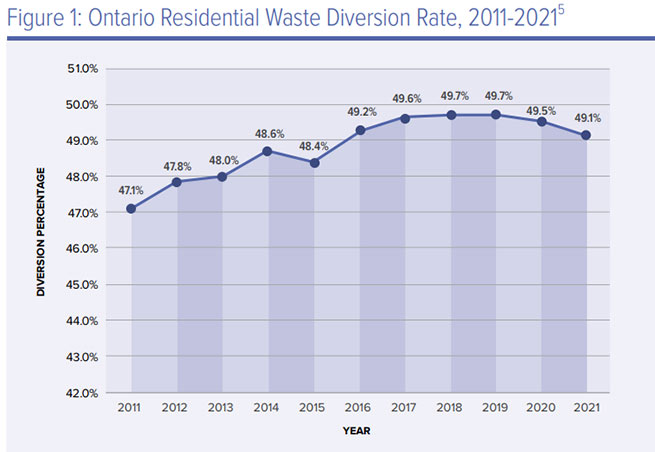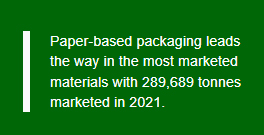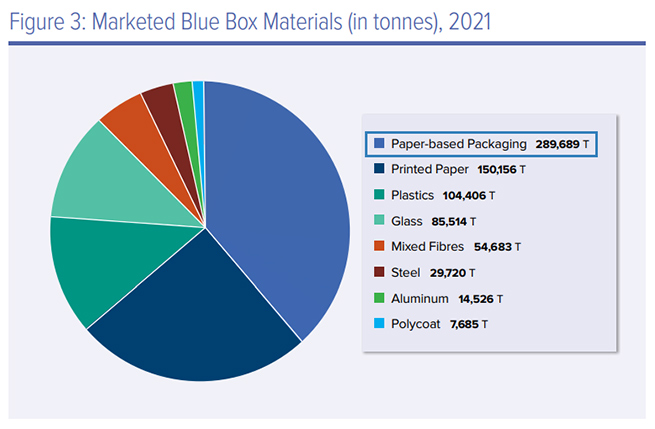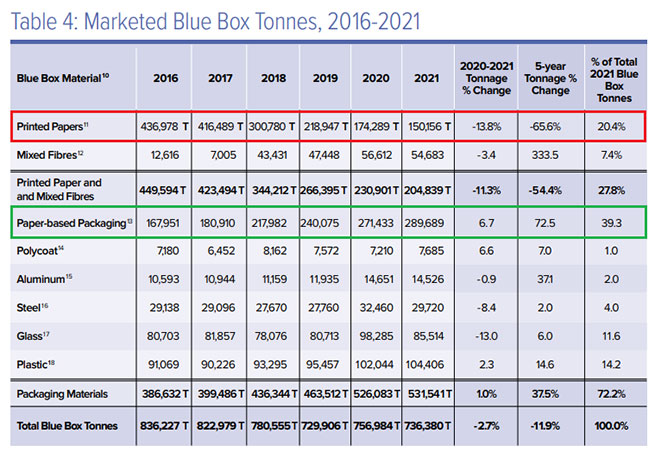Paper-based packaging continues to be a success story in Ontario’s household Blue Box program, as measured by marketed tonnage, based on new data released by the Resource Productivity and Recovery Authority (RPRA), the regulator mandated by the Government of Ontario to enforce the province’s circular economy laws.
RPRA’s new Datacall Report summarizes information generated by the 246 programs participating in the Ontario Blue Box Program in 2021, and highlights residential waste management statistics and trends.
Overall, the program saw a decline in the provincial diversion rate to 49.1%, a stat the program has mostly hovered at for the past 10 years as shown in Figure 1 (all charts in this blog are from RPRA’s Datacall Report).
Diversion is measured after the collected material has been processed at a material recycling facility (MRF). So that essentially means that nearly half of what is placed in the Blue Box does not get recycled, which could be for a number of different reasons, such as contamination (food soiled materials, such as used yogurt or peanut butter containers, for example), materials that are not readily recyclable (e.g., hangers, toys), or residents not properly separating their waste and incorrectly placing non-recyclables (i.e. organics, waste) in their Blue Boxes.

Of interest to the Paper and Paperboard Packaging Environmental Council (PPEC) and its members is marketed Blue Box tonnage (Figure 3), which represents materials that have been sorted and processed by a MRF, and then baled, sold, and used in place of virgin materials.
 These are materials that are actually recycled and paper-based packaging – which includes old corrugated cardboard, old boxboard, and a portion of residential mixed papers and mixed fibres packaging – leads the way in the most marketed materials with 289,689 tonnes marketed in 2021 (up from 271,433 tonnes in 2020), representing 39% of the total Blue Box marketed tonnage (736,379).
These are materials that are actually recycled and paper-based packaging – which includes old corrugated cardboard, old boxboard, and a portion of residential mixed papers and mixed fibres packaging – leads the way in the most marketed materials with 289,689 tonnes marketed in 2021 (up from 271,433 tonnes in 2020), representing 39% of the total Blue Box marketed tonnage (736,379).

The second largest material is printed paper – newsprint, household fine paper, telephone books, and catalogues – with 20% of marketed tonnes. However, this category continues to decline year over year as more homes go paperless (when was the last time you saw a telephone book?!).
Printed papers have experienced a nearly 66% decline in tonnage from 2016-2021, as shown in Table 4, while paper-based packaging has increased by 72.5% over the same period.

In analyzing the latest Ontario Blue Box data, it’s clear that paper is a success story. More than two-thirds of all paper that Ontario households generate is not just collected but actually recycled through Ontario’s Blue Box program. And much of the recovered paper fibres are supplied to PPEC member mills who use it to produce new paper packaging products, including boxes and cartons, made primarily of recycled content.
The Ontario Blue Box program begins its transition to a new producer responsibility regulatory framework starting this July, which will see producers take over 100% of the operational and financial management of the program by December 31, 2025.
There is no doubt that paper-based packaging will continue to be an important component of the Ontario Blue Box program – and PPEC expects to see a continued increase in paper packaging as brands shift from other types of packaging to sustainable, renewable, and recyclable paper-based packaging – but we will be watching the transition closely. The hope is that a shift to a producer responsibility will result in improved end markets, better sorting by residents, less contamination, and overall higher diversion and recycling rates in Ontario.

Glossary of Key Recycling Terms
(Definitions adapted from RPRA)
Collected Blue Box Tonnes: Blue Box materials that are collected curbside and/or at a depot.
Disposed Tonnes: Includes garbage and processing residuals from recycling and composting operations disposed at a landfill or incineration facilities.
Diverted Tonnes: Includes recycling activities, municipal organic collection and processing activities, provincial deposit systems for alcohol containers, residential on-property management and municipally operated reuse activities.
Generated Tonnes: Includes recycling, reuse and garbage material produced by Ontario residents; represents combination of disposed tonnes and diverted tonnes.
Landfilled residential material: Includes garbage Tonnes and processing residues; part of Disposed Tonnes calculation.
Marketed Blue Box Tonnes: Blue Box materials sorted and processed by a Material Recycling Facility (MRF) that is then sold and used in place of virgin materials.
Diversion Rate: Diverted Tonnes / Generated Tonnes x 100
 Rachel Kagan
Rachel Kagan
Executive Director
The Paper & Paperboard Packaging Environmental Council (PPEC)













